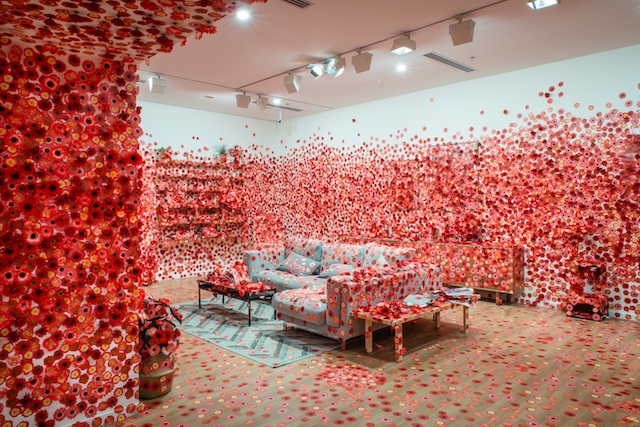The first NGV Triennial in Melbourne is a blockbusting attempt to compete in the global entertainment industry. Opening in the same week as the latest instalment of Star Wars, the exhibition, like the film franchise, encompasses abundant paraphernalia, videogames and other interactive media. The aim is to stage an exhibition – numbering over 100 artists – that is more than simply spectatorial, featuring such participatory novelties as artist-designed cafés, bars and bedrooms. Whether through posts shared on Instagram or the Ron Mueck-designed skateboards available for purchase in the gift shop, this triennial aspires to move out of the museum.
Xu Zhen’s spectacular 18m-long sculpture Eternity-Buddha in Nirvana (2016–17) welcomes visitors into the museum foyer. One of 20 monumental works commissioned for the triennial, Xu’s massive replica of a High Tang Dynasty (705–781 CE) reclining Buddha supports 15 imitation Greco-Roman sculptures, including the Farnese Hercules and the Dancing Faun. The work levels divergent cultural histories, making a statement about the possibility of reciprocity across cultures and presenting monumental sculpture as a form invested with historical meaning. While Eternity-Buddha in Nirvana might serve to stimulate visitors’ engagement with the NGV’s substantial Asian art collection, exhibiting this vast Buddharupa amid the commotion of the triennial also evokes the precarious foundations on which globalised culture stands.
This impulse to spectacularise means that visitors are urged to participate in immersive experiences created by artists whose brands eclipse their work. In a room on the ground floor, Yayoi Kusama’s Flower Obsession (2017) invites visitors into a domestic space where they can plaster cloth flowers over household furniture and walls. In giddy acquiescence, members of the audience coproduce NGV’s marketing campaign by Instagramming their experience. Next to Xu’s centrepiece, visitors can make purchases at a café decorated in a vibrant geometric pattern by British-Moroccan photographer Hassan Hajjaj. A frenetic simulation of a Moroccan teahouse, complete with colourful ottomans and plywood Tayfour tables, Hajjaj’s café redesign is titled Noss Noss (2017). The term denotes coffee with milk, and ‘half-and-half’ makes an apt metaphor for the triennial’s melange of gift shop and gallery, viewer and consumer.
There are moments of reprieve. Yamagami Yukihiro’s installation Shinjuku Calling (2014) uses pencil on painted plywood to depict the streetscape around Shinjuku Station (the world’s busiest train station), including pedestrians and neon signs. The carefully detailed drawing and metallic colour gradient are reminiscent of a distilled image from an anime film, while video projection overlay produces a compelling, spectral movement of people, light and vehicles across the scene. The feeling of calm the work induces is like that of emerging onto the street having been hurried through a railway concourse. Also on the ground floor are four untitled (2015) collages by Kay Hassan. The works are made from torn shreds of billboard posters and other media images reconfigured as largescale portraits of people from Johannesburg. Combining slick media imagery with portraiture, these collages articulate a fragmentation of subjectivity that is typical of our hypernetworked, globalised era. Among the clamour of the triennial they are a useful reminder that the spectacular can distort perspective.
On the museum’s first floor, the ornate extravagance of Guo Pei’s couture comes with a celebrity accreditation: Rihanna wore a magnificent canary-yellow gown to the 2015 Met Gala in New York. Guo’s costumes allude to the convergence of high fashion across different cultural histories, a reminder that part of the allure of clothing – as with art as spectacle – is its unaffordability or impracticality. Issues of (in)accessibility are underscored on level three with Candice Breitz’s Wilson Must Go (2017), a seven-channel HD video installation that grapples with the parameters of empathy. The work draws on the personal narratives of six people seeking refuge (two in Berlin, two in Cape Town and two in New York). Their traumatic stories are told twice: in the first instance, voiced in fragments by Alec Baldwin and Julianne Moore, shown seated in front of green screens; in the second, by the victims themselves. Rather than producing empathy, Wilson Must Go’s celebrity recoding of persecution reinscribes inequality, presenting Hollywood celebrities as arbiters of affect. Breitz changed the name of her work, formerly titled Love Story (2016), as a tepid response to ongoing protests by the local arts community against NGV’s contract with Wilson Security, the company that violently enforces the imprisonment of refugees and asylum seekers in Australia’s offshore detention centres.
The NGV Triennial is a blockbuster, buttressed by spectacle and driven by the assumption that the public demands to be awed. What was an opportunity to engage critically with increasing global demand for market-driven cultural production functions as a perpetuation of those forces, forgoing critique in favour of participation.
NGV Triennial at NGV International, Melbourne, through 15 April
From the Spring 2018 issue of ArtReview Asia
